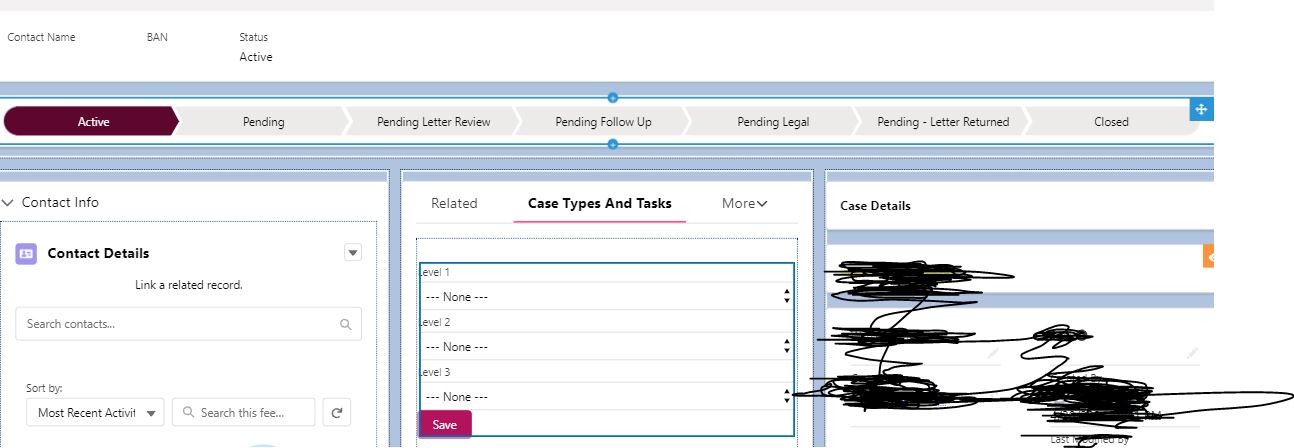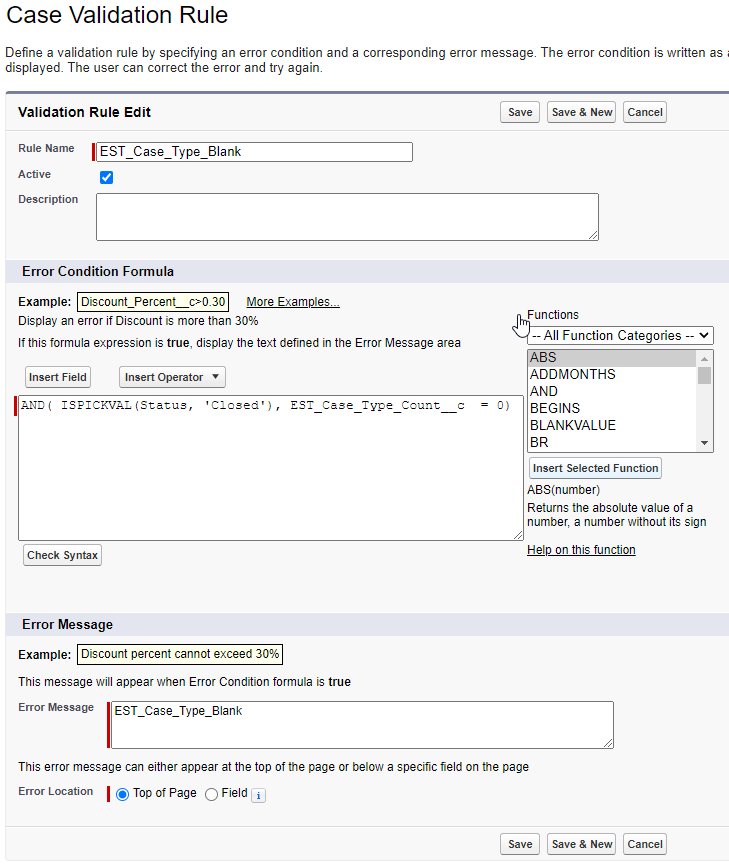You need to sign in to do that
Don't have an account?
Want to add validation in picklist Before Closing a Case
Hi folks,
I have a custom code for dependent Picklist lightning component which is inserted in the case ,like below,now my requirement is whenever user wants to close the case ,i need to display a message in my custom picklist lightning component as below
"Level 1, level 2 and level 3 field must be populated before saving."
Here is the case stages as "CLOSED" and custom picklist component screenshot

Your help is highly apreciated
Regards,
Fiona
I have a custom code for dependent Picklist lightning component which is inserted in the case ,like below,now my requirement is whenever user wants to close the case ,i need to display a message in my custom picklist lightning component as below
"Level 1, level 2 and level 3 field must be populated before saving."
Here is the case stages as "CLOSED" and custom picklist component screenshot
Your help is highly apreciated
Regards,
Fiona






 Apex Code Development
Apex Code Development
Hi Fiona,
Here is what I suggest without making any changes in the lightning component.
1. On the Case Object Create a Rollup Summary Field
2. Use the following Validate Rule on the Case Object

Here is the validation rule code for you convenience
I hope this will help, what you are looking for
All Answers
Is Level 1, Level 2 and Level 3 are custom fields on the case or they are just and input field in the component. Do you know where you store those information on the Case Level?
<aura:component controller="EST_MultiLevelInsertCaseTypes" implements="force:appHostable,flexipage:availableForAllPageTypes,flexipage:availableForRecordHome,force:hasRecordId,forceCommunity:availableForAllPageTypes,force:lightningQuickAction" access="global" > <!-- Actions--> <aura:handler name="init" value="{!this}" action="{!c.doInit}" /> <aura:handler event="force:refreshView" action="{!c.isRefreshed}" /> <!-- variable--> <aura:attribute name="lstLevel1" type="String[]" /> <aura:attribute name="lstLevel2" type="String[]" /> <aura:attribute name="lstL3" type="String[]" /> <aura:attribute name="firstlevel1selected" type="String" default="" /> <aura:attribute name="secondlevelselected" type="String" default="" /> <aura:attribute name="thirdlevelselected" type="String" default="" /> <div class="slds-container--center slds-container--small slds-m-top--small"> <div class="slds-form--stacked"> <lightning:select name="parentPicklist" label="Level 1" aura:id="ddLevel1" onchange="{!c.getLvl1}"> <option value="">--- None ---</option> <aura:iteration items="{!v.lstLevel1}" var="item1"> <option value="{!item1.value}" selected="{!item1.selected}" >{!item1}</option> </aura:iteration> </lightning:select> <lightning:select name="Level2Picklist" label="Level 2" aura:id="ddLevel2" onchange="{!c.getSelectedValue}" > <option value="">--- None ---</option> <aura:iteration items="{!v.lstLevel2}" var="item2"> <option value="{!item2.value}" selected="{!item2.selected}" >{!item2}</option> </aura:iteration> </lightning:select> <lightning:select name="Level3Picklist" label="Level 3" aura:id="ddLevel3" onchange="{!c.getlevel3}" > <option value="">--- None ---</option> <aura:iteration items="{!v.lstL3}" var="item3"> <option value="{!item3.value}" selected="{!item3.selected}" >{!item3}</option> </aura:iteration> </lightning:select> </div> </div> <lightning:button variant="brand" label="Save" onclick="{!c.onConfirm}" /> </aura:component>here is controller. js
({ doInit : function(component, event, helper) { var action = component.get("c.getLevel1"); action.setCallback(this, function(e) { if(e.getState()=='SUCCESS'){ var result=e.getReturnValue(); component.set("v.lstLevel1",result); } }); $A.enqueueAction(action); }, getLvl1:function(component, event, helper){ var picklist=component.find('ddLevel1'); var picklistvalue=picklist.get('v.value'); component.set("v.firstlevel1selected",picklistvalue); var action = component.get("c.getLevel2"); action.setParams({ 'strName' : picklistvalue }); action.setCallback(this, function(e) { if(e.getState()=='SUCCESS'){ var result=e.getReturnValue(); component.set("v.lstLevel2",result); helper.getSelectedValue(component,event,helper); } }); $A.enqueueAction(action); }, getSelectedValue:function(component, event, helper){ var picklist=component.find('ddLevel1'); var picklistvalue=picklist.get('v.value'); var picklistdep=component.find('ddLevel2'); var picklistvaluedep2=picklistdep.get('v.value'); component.set("v.secondlevelselected",picklistvaluedep2); var action = component.get("c.getLevel3"); action.setParams({ 'strName1' : picklistvalue, 'strName2' : picklistvaluedep2});// action.setCallback(this, function(e) { if(e.getState()=='SUCCESS'){ var result=e.getReturnValue(); component.set("v.lstL3",result); } }); $A.enqueueAction(action); }, getlevel3:function(component, event, helper){ var picklist=component.find('ddLevel3'); var picklistvalue=picklist.get('v.value'); component.set("v.thirdlevelselected",picklistvalue); }, onConfirm:function(component, event, helper){ var picklist=component.find('ddLevel1'); var picklistvalue=picklist.get('v.value'); var picklistdep=component.find('ddLevel2'); var picklistvaluedep2=picklistdep.get('v.value'); var picklistdep3=component.find('ddLevel3'); var picklistvaluedep3=picklistdep3.get('v.value'); var action = component.get("c.savecasetype"); action.setParams({ 'level1' : picklistvalue, 'level2' : component.get('v.secondlevelselected'), 'level3' : component.get('v.thirdlevelselected'), 'id' : component.get("v.recordId")}); var toastEvent = $A.get("e.force:showToast"); action.setCallback(this, function(e) { if(e.getState()=='SUCCESS'){ var result=e.getReturnValue(); if(result==='successfull'){ toastEvent.setParams({ "title": "Success!", "message": "The record has been inserted successfully." }); toastEvent.fire(); }else{ toastEvent.setParams({ "title": "Please Select Unique Combination", "message": "Combination Already Exists,Please Select Another Combination." }); toastEvent.fire(); } } $A.get('e.force:refreshView').fire(); }); $A.enqueueAction(action); }, /*page refresh after data save*/ isRefreshed: function(component, event, helper) { location.reload(); } })Here is apex from which data comingpublic class EST_MultiLevelInsertCaseTypes { @AuraEnabled public static List<String> getLevel1(){ List<String> tempLst1 = new List<String>(); for(AggregateResult ar : [select Level_1__c,COUNT(id) from Case_Type_Data__c group by Level_1__c]) { tempLst1.add(''+ar.get('Level_1__c')); } return tempLst1; } @AuraEnabled public static List<String> getLevel2(string strName){ List<String> tempLst2 = new List<String>(); for(AggregateResult ar : [select Level_2__c,COUNT(id) from Case_Type_Data__c where Level_1__c=:strName group by Level_2__c]) { tempLst2.add(''+ar.get('Level_2__c')); } return tempLst2; } @AuraEnabled public static List<String> getLevel3(string strName1,string strName2){ List<String> tempLst3 = new List<String>(); for(AggregateResult ar : [select Level_3__c,COUNT(id) from Case_Type_Data__c where Level_1__c=:strName1 and Level_2__c=:strName2 group by Level_3__c]) { tempLst3.add(''+ar.get('Level_3__c')); } return tempLst3; } @AuraEnabled public static String savecasetype(string level1,string level2,string level3,string id){ string strMsg='successfull'; try{ List<ERT_Case_Type__c> Lvlobj = new List<ERT_Case_Type__c>(); Lvlobj = [SELECT id FROM ERT_Case_Type__c WHERE Case__c=:id and Level_1__c=:level1 and Level_2__c=:level2 and Level_3__c=:level3 LIMIT 10]; if (Lvlobj.size() > 0){ strMsg= 'Combination Already Exists,Please Select Another Combination'; }else{ ERT_Case_Type__c obj=new ERT_Case_Type__c(); Obj.Case__c = id; System.debug('CASE = '+ Obj.Case__c); Obj.Level_1__c=level1; System.debug('Level1 = '+ Obj.Level_1__c); Obj.Level_2__c=level2; System.debug('Level2 = '+ Obj.Level_2__c); Obj.Level_3__c=level3; System.debug('Level3 = '+ Obj.Level_3__c); Insert obj; } } catch(Exception ex){ strMsg='error'; } return strMsg; } }Thanks,
Fiona
Hi Fiona,
Here is what I suggest without making any changes in the lightning component.
1. On the Case Object Create a Rollup Summary Field
2. Use the following Validate Rule on the Case Object

Here is the validation rule code for you convenience
I hope this will help, what you are looking for
Was the last solution working?
I would also like to help on this if not yet resolved
https://developer.salesforce.com/forums/ForumsMain?id=9062I000000IYdpQAG
Please let me know if my solution works or you are looking in a different way.
Thanks ,but still dont see the validation message,created a roll up summary then added a validation rule like
Which SObject you created a rollup summary? Can you share some details Also on which SObject you created a validation rule (They both should be created on the Case SObject). Any details that help me find the issue.
validation rule on case object
will reiterate Level1 ,Level2 and Level3 are fields in ERT_Case_Type__c custtom object and Case has Master detail relationship with ERT_Case_Type__c
Strange so when you try to save the Case with Status = Closed and there is not record in teh ERT_Case_Type__c. You don't see any message from the validation rule. Can you check what you get in the rollup summary when you a record and when you don't (=0)
Is this the way you child ERT_Case_Type__c custom sobject is define
Can you check how that Rollup Summary field shows up on the UI?
This is most out of box solution I can think off. Any other solution will lead us to customization.
Do you need help on this https://developer.salesforce.com/forums/ForumsMain?id=9062I000000IYdpQAG or you are good?